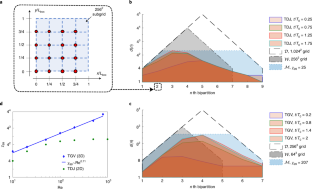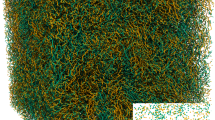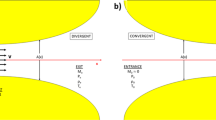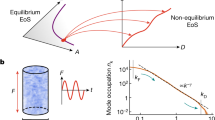Abstract
Understanding turbulence is key to our comprehension of many natural and technological flow processes. At the heart of this phenomenon lies its intricate multiscale nature, describing the coupling between different-sized eddies in space and time. Here we analyze the structure of turbulent flows by quantifying correlations between different length scales using methods inspired from quantum many-body physics. We present the results for interscale correlations of two paradigmatic flow examples, and use these insights along with tensor network theory to design a structure-resolving algorithm for simulating turbulent flows. With this algorithm, we find that the incompressible Navier–Stokes equations can be accurately solved even when reducing the number of parameters required to represent the velocity field by more than one order of magnitude compared to direct numerical simulation. Our quantum-inspired approach provides a pathway towards conducting computational fluid dynamics on quantum computers.
This is a preview of subscription content, access via your institution
Access options
Access Nature and 54 other Nature Portfolio journals
Get Nature+, our best-value online-access subscription
$29.99 / 30 days
cancel any time
Subscribe to this journal
Receive 12 digital issues and online access to articles
$99.00 per year
only $8.25 per issue
Buy this article
- Purchase on Springer Link
- Instant access to full article PDF
Prices may be subject to local taxes which are calculated during checkout



Similar content being viewed by others
Data availability
Our Code Ocean capsule49 contains the raw output data from our MPS simulations. These data were generated using the C functions tntMpsBoxTurbulence2DTimeEvolutionRK2(...) and tntMpsBoxTurbulence3DTimeEvolutionRK2(...), using the initial conditions and parameters defined in the Set-up of numerical experiments section in the Methods. Source data for Figs. 1, 2 and 3 are available via Code Ocean49.
References
Monin, A. S. & Yaglom, A. M. Statistical Fluid Dynamics (Dover, 2007).
Monin, A. S. & Yaglom, A. M. Statistical Fluid Dynamics: Mechanics of Turbulence, Vol. II (Dover, 2007).
Kolmogorov, A. N. The local structure of turbulence in incompressible viscous fluids for very large Reynolds’ numbers. Dokl. Akad. Nauk SSSR 30, 301–305 (1941).
Eyink, G. L. Locality of turbulent cascades. Physica D 207, 91–116 (2005).
Cardesa, J. I., Vela-Martín, A. & Jiménez, J. The turbulent cascade in five dimensions. Science 357, 782–784 (2017).
Chen, S. et al. Physical mechanism of the two-dimensional inverse energy cascade. Phys. Rev. Lett. 96, 084502 (2006).
Orszag, S. A. & Patterson, G. S. Numerical simulation of three-dimensional homogeneous isotropic turbulence. Phys. Rev. Lett. 28, 76–79 (1972).
Hussain, A. K. M. F. Coherent structures—reality and myth. Phys. Fluids 26, 2816–2850 (1983).
Holmes, P., Lumley, J. L., Berkooz, G. & Rowley, C. W. Turbulence, Coherent Structures, Dynamical Systems and Symmetry (Cambridge Univ. Press, 1996).
Taira, K. et al. Modal analysis of fluid flows: an overview. AIAA J. 55, 4013–4041 (2017).
Poulin, D., Qarry, A., Somma, R. & Verstraete, F. Quantum simulation of time-dependent Hamiltonians and the convenient illusion of Hilbert space. Phys. Rev. Lett. 106, 170501 (2011).
Orús, R. A practical introduction to tensor networks: matrix product states and projected entangled pair states. Ann. Phys. 349, 117–158 (2014).
Schollwöck, U. The density-matrix renormalization group in the age of matrix product states. Ann. Phys. 326, 96–192 (2011).
Verstraete, F., Murg, V. & Cirac, J. I. Matrix product states, projected entangled pair states, and variational renormalization group methods for quantum spin systems. Adv. Phys. 57, 143 (2008).
Clark, S. R. & Jaksch, D. Dynamics of the superfluid to Mott-insulator transition in one dimension. Phys. Rev. A 70, 043612 (2004).
Simeng, Y., Huse, D. A. & White, S. R. Spin–liquid ground state of the s = 1/2 Kagome Heisenberg antiferromagnet. Science 332, 1173–1176 (2011).
Horodecki, R., Horodecki, P., Horodecki, M. & Horodecki, K. Quantum entanglement. Rev. Mod. Phys. 81, 865–942 (2009).
Eisert, J., Cramer, M. & Plenio, M. B. Colloquium: area laws for the entanglement entropy. Rev. Mod. Phys. 82, 277–306 (2010).
Onsager, L. Statistical hydrodynamics. Nuovo Cim. 6, 279–287 (1949).
von Weizsäcker, C. F. Das Spektrum der Turbulenz bei großen Reynoldsschen Zahlen. Z. Phys. 124, 614–627 (1948).
Heisenberg, W. Zur statistischen Theorie der Turbulenz. Z. Phys. 124, 628–657 (1948).
Mathis, R., Hutchins, N. & Marusic, I. Large-scale amplitude modulation of the small-scale structures in turbulent boundary layers. J. Fluid Mech. 628, 311–337 (2009).
Givi, P. Model-free simulations of turbulent reactive flows. Prog. Energ. Combust. Sci. 15, 1–107 (1989).
Brachet, M. E. et al. Small-scale structure of the Taylor-Green vortex. J. Fluid. Mech. 130, 411–452 (1983).
Oseledets, I. V. Tensor-train decomposition. SIAM J. Sci. Comput. 33, 2295–2317 (2011).
Holtz, S., Rohwedder, T. & Schneider, R. On manifolds of tensors of fixed TT-rank. Numer. Math. 120, 701–731 (2012).
Lubasch, M., Moinier, P. & Jaksch, D. Multigrid renormalization. J. Comput. Phys. 372, 587–602 (2018).
García-Ripoll, J. J. Quantum-inspired algorithms for multivariate analysis: from interpolation to partial differential equations. Quantum 5, 431 (2021).
Sagaut, P. Large Eddy Simulation for Incompressible Flows: An Introduction (Springer, 2006)
Pope, S. B. Ten questions concerning the large-eddy simulation of turbulent flows. New J. Phys. 6, 35 (2004).
Zhiyin, Y. Large-eddy simulation: past, present and the future. Chin. J. Aeronaut. 28, 11–24 (2015).
Rakhuba, M. V. & Oseledets, I. V. Fast multidimensional convolution in low-rank tensor formats via cross approximation. SIAM J. Sci. Comput. 37, A565–A582 (2015).
Vidal, G. Entanglement renormalization. Phys. Rev. Lett. 99, 220405 (2007).
Evenbly, G. & Vidal, G. Class of highly entangled many-body states that can be efficiently simulated. Phys. Rev. Lett. 112, 240502 (2014).
Libby, P. A. & Williams, F. A. (eds) Turbulent Reacting Flows (Academic, 1994)
Pope, S. B. PDF methods for turbulent reactive flows. Prog. Energ. Combust. 11, 119–192 (1985).
Nouri, A. G., Nik, M. B., Givi, P., Livescu, D. & Pope, S. B. Self-contained filtered density function. Phys. Rev. Fluids 2, 094603 (2017).
Lubasch, M., Joo, J., Moinier, P., Kiffner, M. & Jaksch, D. Variational quantum algorithms for nonlinear problems. Phys. Rev. A 101, 010301(R) (2020).
Lloyd, S. et al. Quantum algorithm for nonlinear differential equations. Preprint at https://arxiv.org/abs/2011.06571 (2020).
Liu, J.-P. et al. Efficient quantum algorithm for dissipative nonlinear differential equations. Proc. Natl Acad. Sci. USA 118, e2026805118 (2021).
Zaletel, M. P. & Pollmann, F. Isometric tensor network states in two dimensions. Phys. Rev. Lett. 124, 037201 (2020).
Lin, S. H., Dilip, R., Green, A. G., Smith, A. & Pollmann, F. Real- and imaginary-time evolution with compressed quantum circuits. PRX Quantum 2, 010342 (2021).
Fiacco, A. V. & McCormick, G. P. Nonlinear Programming: Sequential Unconstrained Minimization Techniques (Wiley, 1968).
Fiacco, A. V. Penalty methods for mathematical programming in en with general constraint sets. J. Optim. Theor. Appl. 6, 252–268 (1970).
Chorin, A. J. Numerical solution of the Navier-Stokes equations. Math. Comput. 22, 745–762 (1968).
Fornberg, B. Generation of finite difference formulas on arbitrarily spaced grids. Math. Comput. 51, 699–706 (1988).
Chorin, A. J. The numerical solution of the Navier-Stokes equations for an incompressible fluid. Bull. Am. Math. Soc. 73, 928–931 (1967).
Foias, C., Manley, O., Rosa, R. & Temam, R. Navier-Stokes Equations and Turbulence, Vol. 83 (Cambridge Univ. Press, 2001).
Gourianov, N. A quantum inspired approach to exploit turbulence structures [source code], https://doi.org/10.24433/CO.4124213.v1 (Code Ocean, 2021).
Al-Assam, S., Clark, S. R. & Jaksch, D. The tensor network theory library. J. Stat. Mech. Theor. Exp. 2017, 093102 (2017).
Jeong, J. & Hussain, F. On the identification of a vortex. J. Fluid. Mech. 285, 69–94 (1995).
Acknowledgements
The work at the University of Oxford was supported by the EPSRC Programme Grant DesOEQ (EP/P009565/1), and M.K. and D.J. acknowledge financial support from the National Research Foundation, Prime Ministers Office, Singapore, and the Ministry of Education, Singapore, under the Research Centres of Excellence programme. D.J. also acknowledges support by the Excellence Cluster ‘The Hamburg Centre for Ultrafast Imaging—Structure, Dynamics and Control of Matter at the Atomic Scale’ of the Deutsche Forschungsgemeinschaft. Current work at the University of Pittsburgh is supported by the National Science Foundation under grant no. CBET-2042918. S.D. is thankful for support from the EPSRC New Investigator Award (EP/T031255/1) and New Horizons grant (EP/V04771X/1). The funders had no role in study design, data collection and analysis, decision to publish or preparation of the manuscript. We also acknowledge the use of the University of Oxford Advanced Research Computing (ARC) facility in carrying out this work (https://doi.org/10.5281/zenodo.22558). Finally, we thank the scientists and engineers at BAE Systems, Bristol for fruitful discussions and advice.
Author information
Authors and Affiliations
Contributions
D.J. conceived the research project and N.G., M.L., P.G. and D.J. jointly planned it. N.G., M.L., S.D., M.K. and D.J. developed the quantum-inspired measure for interscale correlations based on Schmidt decompositions and hierarchical lattices. N.G., M.L. and S.D. formulated the matrix product state algorithm and carried out the analytical calculations. N.G., Q.Y.v.d.B. and M.K. wrote the software. N.G., H.B. and P.G. designed the numerical experiments for comparing MPS, URDNS and DNS. N.G. performed the numerical experiments. N.G., M.L., S.D., H.B., P.G., M.K. and D.J. analyzed and interpreted the numerical results. N.G., M.K. and D.J. wrote the manuscript with contributions from M.L., S.D., H.B. and P.G., and Q.Y.v.d.B. helped revise the manuscript. The Supplementary Information was written by N.G., M.L., S.D. and M.K.. The project was supervised by D.J.
Corresponding authors
Ethics declarations
Competing interests
The authors declare no competing interests.
Peer review
Peer review information
Nature Computational Science thanks Koji Fukagata, Nuno Loureiro and the other, anonymous, reviewer(s) for their contribution to the peer review of this work.
Additional information
Publisher’s note Springer Nature remains neutral with regard to jurisdictional claims in published maps and institutional affiliations.
Editor recognition statement Handling editor: Jie Pan, in collaboration with the Nature Computational Science team.
Supplementary information
Supplementary Information
Supplementary Figs. 1–7 and sections 1–6.
Rights and permissions
About this article
Cite this article
Gourianov, N., Lubasch, M., Dolgov, S. et al. A quantum-inspired approach to exploit turbulence structures. Nat Comput Sci 2, 30–37 (2022). https://doi.org/10.1038/s43588-021-00181-1
Received:
Accepted:
Published:
Issue Date:
DOI: https://doi.org/10.1038/s43588-021-00181-1
This article is cited by
-
An efficient quantum partial differential equation solver with chebyshev points
Scientific Reports (2023)
-
Towards quantum computing of turbulence
Nature Computational Science (2022)
-
Variational quantum evolution equation solver
Scientific Reports (2022)
-
Variational quantum solutions to the advection–diffusion equation for applications in fluid dynamics
Quantum Information Processing (2022)



